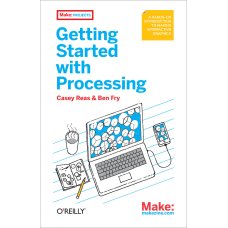Learn computer programming the easy way with Processing, a simple language that lets you use code to create drawings, animation, and interactive graphics. Programming courses usually start with theory, but this book lets you jump right into creative and fun projects. It's ideal for anyone who wants to learn basic programming, and serves as a simple introduction to graphics for people with some programming skills.
Written by the founders of Processing, this book takes you through the learning process one step at a time to help you grasp core programming concepts. You'll learn how to sketch with code -- creating a program with one a line of code, observing the result, and then adding to it. Join the thousands of hobbyists, students, and professionals who have discovered this free and educational community platform.
- Quickly learn programming basics, from variables to objects
- Understand the fundamentals of computer graphics
- Get acquainted with the Processing software development environment
- Create interactive graphics with easy-to-follow projects
- Use the Arduino open source prototyping platform to control your Processing graphics
About the Authors
Casey Reas is a professor in the Department of Design Media Arts at UCLA and a graduate of the MIT Media Laboratory. Reas' software has been featured in numerous solo and group exhibitions at museums and galleries in the United States, Europe, and Asia. With Ben Fry, he co-founded Processing in 2001. He is the co-author of Processing: A Programming Handbook for Visual Designers and Artists (2007) and Form+Code in Design, Art, and Architecture (2010). His work is archived at http://www.reas.com.
Ben Fry has a doctorate from the MIT Media Laboratory and was the 2006-2007 Nierenberg Chair of Design for the Carnegie Mellon School of Design. He worked with Casey Reas to develop Processing, which won a Golden Nica from the Prix Ars Electronica in 2005. Ben's work has received a New Media Fellowship from the Rockefeller Foundation, and been shown at the Museum of Modern Art, Ars Electronica, the 2002 Whitney Biennial, and the 2003 Cooper Hewitt Design Triennial.
Chapter 1 Hello
- Sketching and Prototyping
- Flexibility
- Giants
- Family Tree
- Join In
Chapter 2 Starting to Code
- Your First Program
- Show
- Save
- Share
- Examples and Reference
Chapter 3 Draw
- Basic Shapes
- Drawing Order
- Shape Properties
- Color
- Custom Shapes
- Comments
- Robot 1: Draw
Chapter 4 Variables
- Making Variables
- Processing Variables
- A Little Math
- Repetition
- Robot 2: Variables
Chapter 5 Response
- Follow
- Map
- Click
- Location
- Type
- Robot 3: Response
Chapter 6 Media
- Images
- Fonts
- Shapes
- Robot 4: Media
Chapter 7 Motion
- Speed and Direction
- Tweening
- Random
- Timers
- Circular
- Translate, Rotate, Scale
- Robot 5: Motion
Chapter 8 Functions
- Function Basics
- Make a Function
- Return Values
- Robot 6: Functions
Chapter 9 Objects
- Classes and Objects
- Robot 7: Objects
Chapter 10 Arrays
- Make an Array
- Repetition and Arrays
- Arrays of Objects
- Robot 8: Arrays
Chapter 11 Extend
- 3D
- Image Export
- Hello Arduino
- Community
Appendix Coding Tips
- Functions and Parameters
- Color Coding
- Comments
- Uppercase and Lowercase
- Style
- Console
- One Step at a Time
Appendix Data Types
Appendix Order of Operations
Appendix Variable Scope
Colophon
Getting Started with Processing
- Brand: Make:
- Product Code:Bok-Get-Start-w-Processing
- Reward Points:3
- Availability:In Stock
-
रo 300.00
- Price in reward points:300
Tags: Processing, Book


